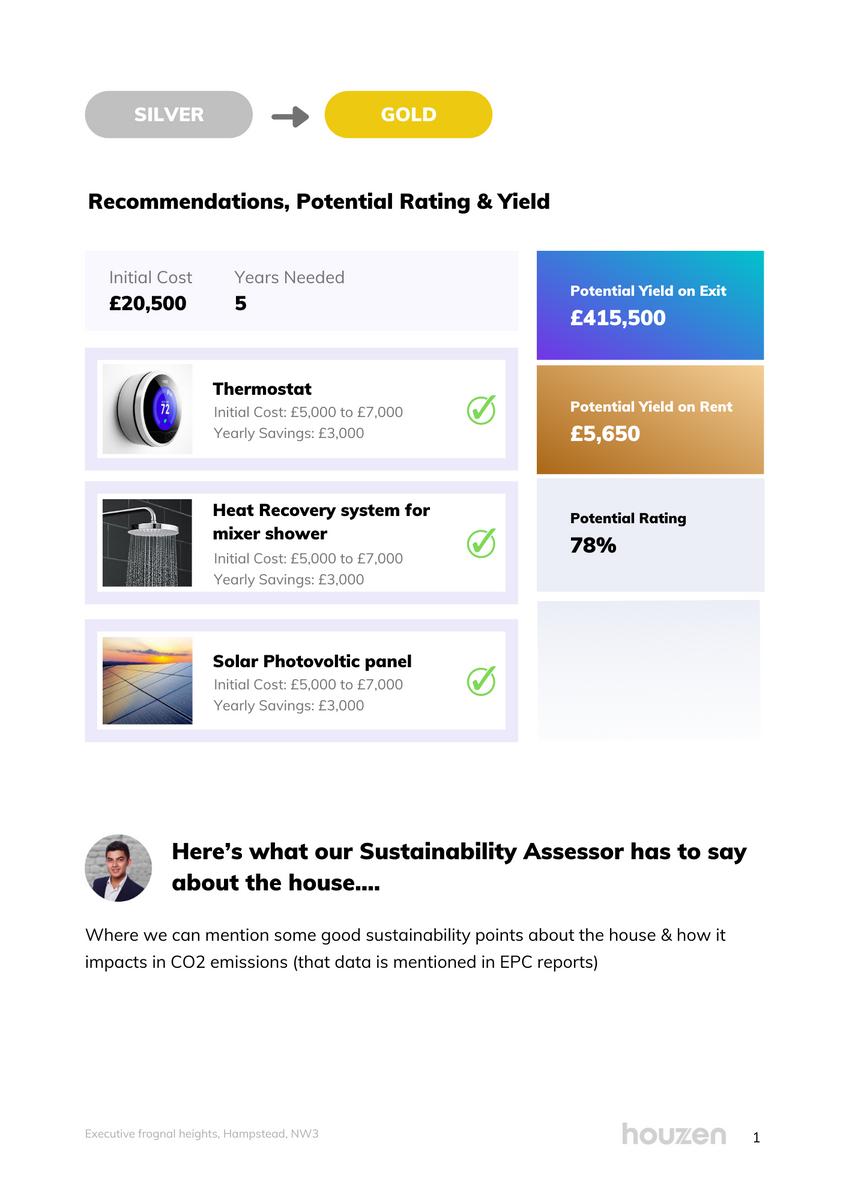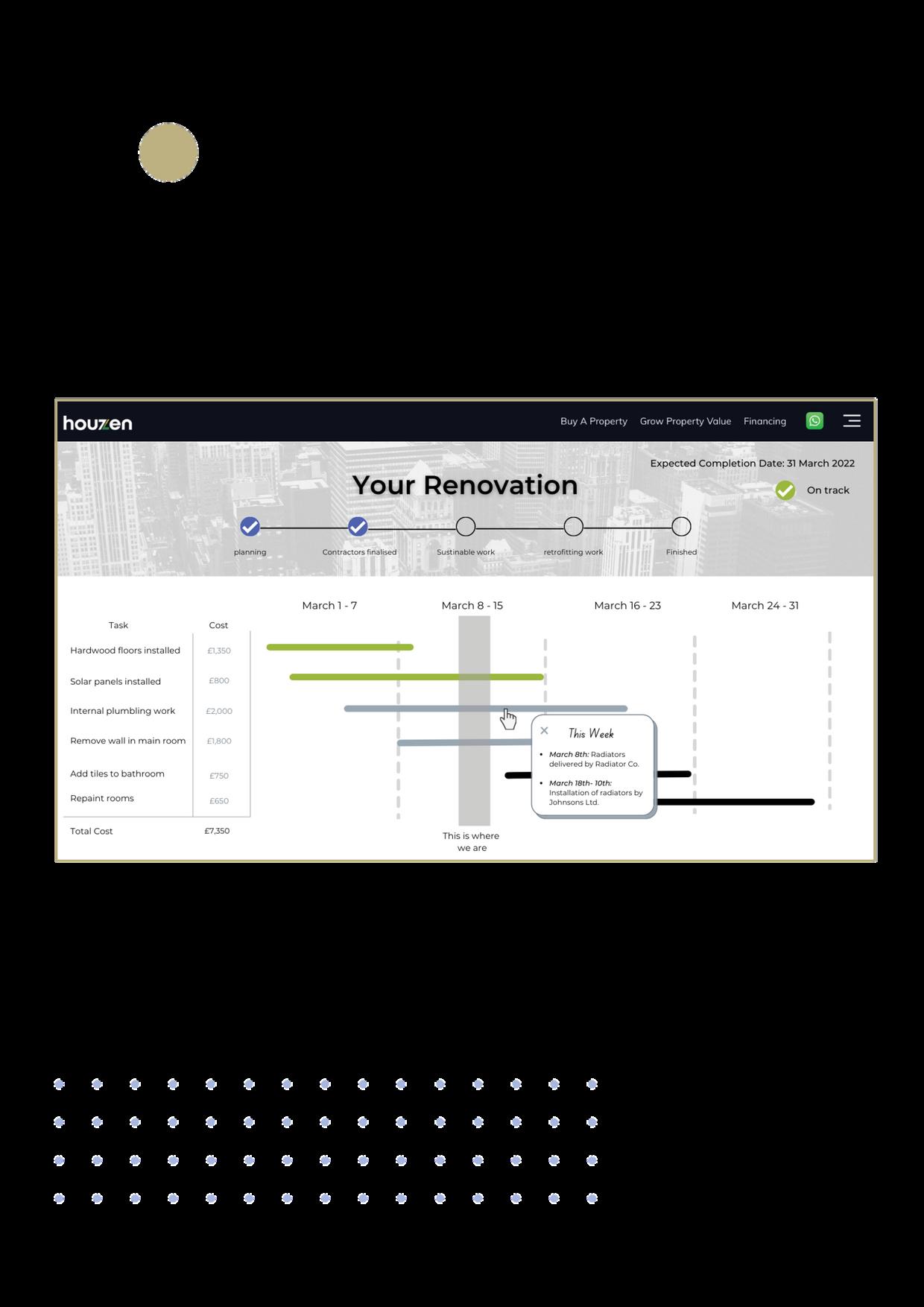How To Decarbonise UK Housing Stock At Scale




CONTENT 01. Key Findings 0.2 Introduction 03. What is decarbonisation in housing? 04. Homeowner Barriers to Retrofitting 05. Implementation Barriers 06. Government Intervention Tax breaks for first movers Restructuring benefits system for fuel poverty Low-interest loans and specialised mortgage products Sponsored content promoting retrofitting 07. The 3 Step Solution Real-Time analysis on properties. Sourcing Financing Digital Property Management. 08. Roadmap and Next Steps 09. Final Comments 10. References 04 05 06 07 08 10 13 15 16 16
This paper investigates the hypothesis that decarbonising existing housing stock can be achieved successfully through an intermediary showcasing the benefits of retrofitting that property, and sufficient allocation of capital from private and public sources.

It attempts to create conversations between private markets and government bodies to accelerate the rate of decarbonising homes in the UK.

3
KEY FINDINGS
As it stands, 21.3 million homes in the UK will need some type of retrofit to achieve 2050 Carbon Net Zero Targets With 63% of occupants owning their homes in England, the problem is: how to incentivise private homeowners to perform these retrofits?
Supply constrictions with natural gas, higher rates of inflation, pressure for energy companies to find cleaner alternatives, naturally means that the cost of energy will continue to increase; therefore, exposing more than 2.5 million people to fuel poverty
To overcome the barriers to retrofitting homes, a platform needs to be created to showcase the benefits of retrofitting the property (both visually and financially) to accelerate decarbonising the UK housing market. The increased demand for sustainable retrofits will help achieve economies of scale for innovative startups developing decarbonising technologies, reducing cost per unit and further increasing the number of retrofits The key is to incentivise deep retrofits over shallow retrofits as this will enable the intermediary to collect more data on retrofit projects that can be used for quantifying the risks; an essential part for both insurance and financial providers
Aside from the availability of finance, marketing strategy, supply of sustainable products, and insurance data, the key to success does not happen without significant government intervention Government Intervention is necessary to retrofit low income households
Introduction of tax breaks for first movers, restructuring benefits system for fuel poverty, and subsidies for marketing are some of the key proponents required to retrofit at a large scale.
The data collected from sustainable retrofitting can be used for risk and financial modelling for projects Further increasing the appeal for retrofits with accurate insurance policies and low interest financial products
The above findings from the application on private homes can then be applied to social housing by; building social housing for the long term not the near term through the reducing costs of sustainable products/materials, ability to obtain lower interest rate loans from lenders, and improved risk and financial modelling on retrofitting projects providing better budget management.

4
INTRODUCTION

As many as 90% of today’s buildings will still be in use in 2050, yet 75% of the buildings in the EU are currently classed as energy inefficient. The problem with inefficient homes is that they require more energy to heat which is the main problem for most part of the year in Europe 2021 has shown the risks associated with having inefficient homes (2019 statistics show that 3.52m households are in fuel poverty , this is expected to increase to 6m in 2022 with a 50% increase in fuel prices in the first half of 2022) Out of 29 million homes in the UK, 19 million homes are below band C according to the Committee on Climate Change . houzen’s AI discovered that 21 3 million homes will need some type of retrofit With 63% of occupants in England owning their own homes and with similar rates across Europe, the only way we can get towards meeting carbon net zero is to make retrofitting financially executable at all income levels. This means that there needs to be a proper incentive and penalties for homeowners to consider sustainable solutions.
Investigating the hypothesis that decarbonising existing housing stock can be achieved successfully through an intermediary showcasing the benefits of retrofitting that property, and sufficient allocation of capital from private and public sources. The intermediary, in this case, houzen, will showcase before and after images of the property, sources of financing and monetary benefits, and a digital management system. This paper explores the pain points behind retrofits, the implementation barriers, government intervention required, and our solution to ensure accelerated deployment of retrofits in the UK

5
Meet
guidelines Below EPC Band C Band C+but does not meet guidelines 26.6% 11.4% 62.1%
Uk Housing Stock that meet Government 2050 Guidelines
2050
[1] [2] [3] [4] [5]
WHAT IS DECARBONISATION IN HOUSING?
houzen’sdefinitionofdecarbonisationofhousing: Retrofittingarealestateassetinwaysthateitherreducetheenergydemand requiredorchangetheenergysourcetoalower,carbon emittingone.


6
HOMEOWNERS' BARRIERS TO RETROFITTING
Retrofits that are required to assist towards carbon net-zero have pain points from the public that need to be addressed before coming to a solution
Generally speaking, retrofitting fits into two categories Shallow retrofits focus on the installation of cost effective measures (such as installing energy efficient lights) and can enable 10 30% CO2e reduction, while deep retrofit addresses the whole house in detail and can enable up to 80% CO2e reduction, albeit with a significant increase in costs as such efficiencies are approached Whilst achieving 80% is both costly and technically difficult, achieving reductions of 50 60% is more economically and technically achievable . In Europe, only 0.2% of properties have had deep retrofits . At that speed, retrofitting all would take until 2500. To understand why this is happening at such a low rate, we need to perform a force field analysis:
[7]
“For” Deep-Retrofitting “Against” Deep-Retrofitting




£8.61bn could be saved in energy bills annually if all homes were improved to EPC rating C Lower energy demand, lower exposure to fuel price risk Properties lower than band D require 48% more damp and mould related maintenance and repairs than A D rated properties Reduction in personal carbon footprint
An A EPC rated property is growing 14% vs G property that grew 6% on average.
[8] [9] [10] [11]
Deep Retrofitting is expensive. For example, Air source heat pumps cost £6,000 £8000 and ground source heat pumps £10,000 £18,000 to install Finding the products, financing, and skilled workers are difficult to find The payback period for most retrofitting projects is over a long period. 48 years for renewable options Risk of the project being over budget and time Not all buildings can be deep retrofitted economically Victorian houses were designed to breathe that will need bespoke solutions to retrofit. Lack of understanding of how it will benefit the homeowners I e uplift in home value and bills saved.
[12]
The rationale for trying to enforce deep retrofits vs shallow retrofits is purely from the data perspective Shallow retrofits only create marginal improvements to housing and will not solve the issue of carbon emissions in existing UK housing stock.
7
[6]
IMPLEMENTATION BARRIERS



Without several factors, including government intervention, it will be improbable to achieve carbon net zero This is a top down approach to what needs to be done to achieve this target by 2050
Although this is a worldwide problem, for the focus of this paper we are only focusing on UK deployment, as this will be crucial to understand first before deployment in Mainland Europe and additional markets. It is clear that the success of this project comes from several factors:
ADVERTISING
Crucial for any business Only one S&P500 company does not have an advertising budget, Tesla. Its marketing is being funnelled through its celebrity founder, Elon Musk. Concerning decarbonising the housing stock at scale, as explained earlier, a level of education is required to achieve critical mass. Critical mass is when the product becomes self sufficient Now that Governments are working towards phasing out fossil fuels, regulations should make achieving critical mass more achievable. Marketing will take two approaches; one that encourages virality through social media and traditional media platforms and the other using traditional targeted marketing through SEO There is currently not enough “green and sustainability linked” financing options available and certainly not a centralised portal to find options. Famously GovUK scrapped the Green Homes Grant scheme in 2021 that had the goal to fund renovations for 600,000 homes, but by the end of the scheme, only 47,500 homes were renovated They have now introduced the Renewable Heat Incentive (RHI) , that for domestic ground heat pumps installed, homeowners can make as much as £9,000 from the scheme (before considering an uplift in real estate asset value) Deeper implementation of financing can come from the following ways:
AVAILABILITY OF FINANCING
a) Sharing of data collected from sustainable retrofitting projects with banks and building societies to increase confidence and reduce the risk for these types of projects (see the roadmap for more information).
b) Create a financial product designed using proprietary data collected from retrofitting projects to calculate competitive quantum for projects. Achieving FCA and raising capital from sophisticated investors can generate healthy yield returns. This must be taken with precaution, as overreliance on AI to forecast the exit value can spell disaster Over Reliance on its AI has led to Zillow, a US iBuyer, buying a surplus of 7000 homes many of which they are now forced to sell at loss .
c) Collaborating with financial institutions to share API key’s of suitable financial products that can be applied.
8
[14] [15]
[13]
ACCESSIBILITY SUSTAINABLE PRODUCTS

Sustainable products are expensive and not readily available. Partially to do with the Covid pandemic and supply restrictions, and partially with economies of scale not achieved. The technology to retrofit is available; however, these are mostly still expensive The main issue for innovative junior companies is how to spread awareness of the products Collaborating with these companies on a centralised platform will spread awareness, and in collaboration with government grants and financing instruments, should make these more affordable The Government Net Zero strategy will assist in reducing prices through an increased number of projects For example, Renewable Heat Incentive Grant has encouraged the demand for heat pumps although criticised it is as not enough to displace gas boilers
INSURANCE

Asking the public to perform sustainable retrofitting is a big ask, and frankly, for an outsider who has a limited understanding of finance, engineering, and sustainability in housing, it requires a lot of security to persuade a homeowner to do such a large task. Therefore insurers will need to consider the following risks; technical default, financial risk, contractor risk, property damage, and energy demand reduction not met The problem from an insurance perspective is that little is understood about the risks associated with decarbonising properties Implementation will come from working with specific insurance firms that cover these types of threats and share stochastic modelling of energy and exit value of the project
GOVERNMENT INTERVENTION
[16] [17]
Policies, grants and investment vehicles are essential for achieving critical mass The UK government has announced a long term strategy to retrofit all homes by 2040 This would cost £524bn in total, of which the government would need to invest £168bn, and would create 500,000 jobs The Net Zero strategy proposed by the Department for Business, Energy & Industrial Strategy has provided an initial 20 year strategy, allowing heat pumps to become cheaper through widespread deployment and deciding which fuel becomes more technologically viable hydrogen, electricity, or a mixture of both.
Policies like landlords being unable to lease homes if under EPC Band C from 2025 is a step in the right direction However, the government would need to ensure that measures are taken to support the homeowner through financial aid. By having a simple, straightforward, and more inclusive process so that there isn’t a big financial burden on the homeowner and more people will be able to benefit from the grants
9
[18]
GOVERNMENT INTERVENTION
A two step approach needs to be taken to ensure that the burden is not unnecessarily pushed to the taxpayer The thesis is to scale for private homes and the Private Rent Sector, with the help of government intervention, to achieve economies of scale of sustainable products, then to be introduced to social housing This is to prevent unnecessary spending on social housing
Below are the proposed strategies that should be implemented to incentivise private homeowners, but at the same time mitigate the risk of low income homeowners being priced out and being further exposed to fuel poverty.
TAX BREAKS FOR FIRST MOVERS
The government currently has few tax incentives for efficient homes. It is not enough for current homeowners or flippers to convert inefficient homes into efficient homes Introducing a stamp duty tariff dependent on the energy performance of the house could be a way to incentivise current homeowners By then introducing a tax credit for buyers who transform their homes could be an even more attractive option for property investors or BTL landlords who are required to make their homes more efficient if they want to lease out the property.
For this to be successful and not to be abused, retrofitting will need to be regulated and only be performed by a certified body. The standards need to cover technical issues in an integrated way to overcome problems, for example, with the UK’s poor experience where heat pumps were installed in higher risk buildings where the necessary fabric improvements had not been made. The technical standards need to be developed in those areas where they are currently absent (eg insulation measures) and must be linked, through the renovation plan
process, with optimal combinations of fabric and systems. This ensures that the homes that are passed on are not of poor quality
For UK investors, SEIS schemes have provided excellent hedging tools for investors, providing 50% tax relief up to £100k The increase in funding doubled since the introduction of SEIS in 2012 Similar tax relief for sustainability focused investors would encourage the growth of research and development in this area
Companies raising funds for the first time
Companies raising funds for the subsequent no lund

A m o u n t o f i n v e
t m
( £
) 0 2012 13 2013 14 20 40 60 80 100 120 140 160 10
s
e n t
m
RESTRUCTURING BENEFITS SYSTEM FOR FUEL POVERTY
The UK Government wants to be world leading in combating climate change. For the purposes of this document, the only reference and recommendations made would be focusing on residential heat and buildings As it stands, the literature used within the Energy White Paper and the Net Zero Strategy the only real mention of addressing fuel poverty has been extending the Warm Home Discount from March 2022 to 2025/26 and increasing from £350 million to £475 million per annum to support three million homes in total with £140 off electricity bills. However, plans to “ban” gas boilers and regulatory changes to make the grid either hydrogen, electricity, or a combination of both will mean that bills will just continue to increase and will price out low income households Combined with transitory inflationary pressures experienced in the UK, fuel poverty has the potential to balloon out of control. This should be instead replaced by direct government grants for whole house retrofits, funded by general taxation as this looks to help solve the problem rather than put a bandaid on as the current fuel credits look to achieve Research on the cost of housing related ill health, where poor housing conditions are the main contributor, estimates that the annual cost to the NHS is £2.5bn. Retrofitting homes, where cost effective and feasible, will fund itself through an increased number of jobs performing retrofits and increased productivity as fewer time workers ill

11 [19] [17]
LOW INTEREST LOANS AND SPECIALISED MORTGAGE PRODUCTS
The existing mortgage market should be expanded to increase lending or retrofit measures as well as reduced interest rates for low energy demand properties A platform like houzen can help develop the database required for financial institutions. This will incentivise retrofits at the point of sale, minimising disruption to the household
With over 36% of homeowners being 65 and over , special considerations must be given to retrofitting advertising towards this demographic. The types of mortgages offered to elderly homeowners are equity releases, lifetime mortgages (a form of equity release), and retirement interest only mortgages. However, as people are living longer and able lives, there should be an option for older people to take loans to retrofit properties to make them more efficient. This can be done in two ways: in the form of a convertible note that can either be paid as an interest only mortgage or upon death converts into the equity of the property, or a low interest lifetime loan that if unpaid, to be paid by beneficiaries upon inheritance transfer.
SPONSORED CONTENT PROMOTING RETROFITTING
Although not related to financial incentivising homeowners, acceleration does not happen without public awareness The Montreal Protocol of 1987 to save the ozone layer, is comparable to the Paris Agreement of 2016 to reduce global warming to below 1 5 Celsius Both require public adoption to stop an unseeable threat, that has real consequences One of the main driving factors that got the public on board was the reference of the ozone layer in TV shows and Movies Home makeover shows like “Homes under the hammer”, “60 minute makeover”, and “Grand Designs” These shows inspire people to make their home improvements and investment into a sustainable retrofitting show that encourages improved wellbeing and decarbonisation should accelerate the implementation of these projects

12 [20]
THE 3 STEP SOLUTION
houzen has devised a simple three step solution harbouring the technology of its current business to accelerate deep retrofitting:
REAL-TIME ANALYSIS ON PROPERTIES.
Through AI and Computer Vision, homeowners can quickly identify improvements required and how much they can increase value
SOURCING FINANCING.
Using API keys from banks, building societies, and governments can identify grants, traditional financing, and green financing available to find the lowest cost for the homeowner.


1 2 13
DIGITAL PROPERTY MANAGEMENT.
Using a platform of certified contractors who are trained to install deep retrofitting technology The homeowner can take intermittent videos to check on the progress of the project, and automated payments based on specific task completion are paid out for efficiency and transparency of the construction process. This ensures that this is installed to the highest quality, on time and on budget houzen will also screen every contractor to ensure that they are of the correct standards to perform the job.

3
14
ROADMAP & NEXT STEPS
Considering a combination of the Construction Leadership Council’s (CLC) recommendations and the BEIS’s Net Zero Strategy houzen has devised the following roadmap: Perform deep retrofit on properties that are A C, D E, F G rated, to collect more data and identify other potential risks
Marketing targeting virality through traditional media channels and SEO, directing potential customers to houzen’s platform
Use project knowledge on privately owned homes, focusing on sustainable ROI, and apply this to social housing projects
Data collection on retrofitting projects will allow us to create stochastic models that can be used to translate the technical project risks into financial ones.

This will have the following benefits:
increase confidence in FV of projects, increase finance availability through providing more data to financial institutions (or houzen's off own balance sheet), ability to underwrite projects through uncovering data points on retrofitting projects
Understanding of UK private and social housing, expansion to Europe and America
5 15 [21]
1 2 3 4
Clearly, there is an education and investment gap to achieve carbon net zero An intermediary that combines the benefits of retrofits and the private and public funding available will accelerate the process of reaching carbon net zero
THIS IS WRITTEN BY
Joe Wood Investment Associate for houzen

joseph@houzen co uk
FINAL COMMENTS REFERENCES
1 A/O PropTech. (2021). The Global Retrofitting Challenge [online] Available at: https:// www.aoproptech.com/the global retrofitting challenge/ [Accessed 19 Jan 2022]
2 HM Government (2021) Annual Fuel Poverty Statistics in England, 2021 (2019 data) Available at: https://assets publishing service gov.uk/government/uploads/system/uploads/ attachment data/file/966509/Annual Fuel Poverty Statistics LILEE Report 2021 2019 data pdf [Accessed 19 Jan 2022]
3 National Energy Action (NEA) (n d ) Energy crisis [online] Available at: https://www nea org uk/energy crisis/ [Accessed 19 Jan 2022]
4 Committee on Climate Change (2019) UK housing: Fit for the future? Committee on Climate Change. [online] Available at: https://www theccc org uk/wp content/
Eashita Saxena

Sustainability Analyst for houzen eashita@houzen co uk
uploads/2019/02/UK housing Fit for the future CCC 2019 pdf

5 HM Government (2022) Home ownership [online] Service gov uk Available at: https:// www.ethnicity facts figures.service.gov.uk/ housing/owning and renting/home ownership/ latest
6 Jones, P , Lannon, S , and Patterson, J (2013) Retrofitting existing housing: how far, how much?
Building Research & Information, 41, pp. 532 550
7 Bothwell, K , Saich, M and Mallion, P (2011) Retrofit of existing housing in the United Kingdom: the carbon reduction possibilities. Architecture and Sustainable Development, Proceedings of PLEA 2011, Louvain la Neuve, Belgium (July 2011).
16
8 Bloomberg Retrofitting Buildings Is the Unsexy Climate Fix the World Needs [online] Available at: https://www bloomberg com/news /articles/2021 10 20/climate change insulation hvac are construction solutions to emissions
9 Building the Future: The economic and fiscal impacts of making homes energy efficient (2014) [online] Available at: https:// sustainableenergyassociation.com/wp content/ uploads/2014/10/Building the Future The Economic and Fiscal impacts of making homes energy efficient pdf
10 PassivHaus Trust (2016) Touching the voices: The impact of energy efficiency on social landlord income and business plans Available at: https://www.passivhaustrust.org.uk/ UserFiles/File/PH%20Social/touching the voids Sustainable%20Homes.pdf
11 Moneysupermarket com Improving your home value through energy efficiency. Available at: https://www moneysupermarket com/gas and electricity/value of efficiency/ [Accessed 19 Jan. 2022].
12 Jafari, Amirhosein & Valentin, Vanessa. (2017) Sustainable impact of building energy retrofit measures Journal of Green Building 12 69 84. 10.3992/1943 4618.12.3.69.
13 HM Government (2021) PAC report: Green Homes Grant scheme “underperformed badly” Available at: https://committees parliament uk/ committee/127/public accounts committee/ news/159264/pac report green homes grant scheme underperformed badly/

14 Ofgem (2020) Domestic Renewable Heat Incentive (Domestic RHI) [online] Available at: https://www.ofgem.gov.uk/environmental and social schemes/domestic renewable heat incentive domestic rhi
15 Putzier, W P and K (2021) What Went Wrong With Zillow? A Real Estate Algorithm Derailed Its Big Bet Wall Street Journal [online] 17 Nov. Available at: https://www.wsj.com/ articles/zillow offers real estate algorithm homes ibuyer 11637159261
16 BBC News (2021) Heat pump grants worth £5,000 to help replace gas boilers [online] 19 Oct. Available at: https://www.bbc.co.uk/news/ business 58959045
17 HM Government (2021) Net Zero Strategy: Build Back Greener [online] 20 July 2021 Available at: https://assets.publishing.service. gov uk/government/uploads/system/uploads/ attachment data/file/1033990/net zero strategy beis.pdf
18 HM Government (2021) Minimum Energy Performance of Buildings Bill [HL] Available at: https://bills parliament uk/publications/42300/ documents/572
19 HM Government (2020) Powering our Net Zero Future. Available at: https://assets. publishing service gov uk/government/ uploads/system/uploads/attachment data /file/945899/201216 BEIS EWP Command Paper Accessible pdf
20 Statista England: age distribution of home owners 2020 [online] Available at: https://www statista.com/statistics/321065/uk england home owners age groups/16 BEIS EWP Command Paper Accessible.pdf [Accessed 19 Jan 2022]
21 Construction Leadership Council (CLC) (2020) Greening Our Existing Homes National retrofit strategy A consultative document Available at: https://www. constructionleadershipcouncil co uk/wp content/ uploads/2020/12/CLC National Retrofit Strategy final for consultation pdf
17





























